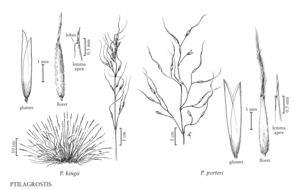Difference between revisions of "Ptilagrostis porteri"
FNA>Volume Importer |
FNA>Volume Importer |
||
| Line 39: | Line 39: | ||
|publication year= | |publication year= | ||
|special status= | |special status= | ||
| − | |source xml=https://jpend@bitbucket.org/aafc-mbb/fna-data-curation.git/src/ | + | |source xml=https://jpend@bitbucket.org/aafc-mbb/fna-data-curation.git/src/f6b125a955440c0872999024f038d74684f65921/coarse_grained_fna_xml/V24/V24_194.xml |
|subfamily=Poaceae subfam. Pooideae | |subfamily=Poaceae subfam. Pooideae | ||
|tribe=Poaceae tribe Stipeae | |tribe=Poaceae tribe Stipeae | ||
Revision as of 19:14, 24 September 2019
Culms 23-50 cm tall, 0.6-1.2 mm thick. Lower ligules 0.7-1.5 mm; upper ligules to 2.5 mm; blades filiform, 0.3-0.6 mm in diameter. Panicles 7.5-12 cm, open or loosely contracted; branches spreading. Glumes 4.5-6 mm; florets 2.5-4 mm; calluses 0.1-0.8 mm; lemmas with 0.2-0.8 mm lobes; awns 5-25 mm, hairy, hairs on the lowest segment 1-2 mm; anthers 1.2-3 mm, glabrous. 2n = unknown.
Discussion
Ptilagrostis porteri grows on hummocks of poorly drained wetlands, at 2700-3600 m, in central Colorado. It is often associated with Salix spp. and Deschampsia cespitosa. There are 29 known populations.
The proportion of plants having closed and open panicles varies among the populations; in some populations all or almost all plants have open panicles, in others all or almost all plants have closed panicles (Johnston 2006). Barkworth (1983) treated P. porteri as a subspecies of P. mongolica (Turcz. ex Trin.) Griseb. because of their morphological similarity. They differ ecologically and geographically, P. mongolica sensu stricto growing in rocky alpine habitats of central Asia.
Selected References
None.
